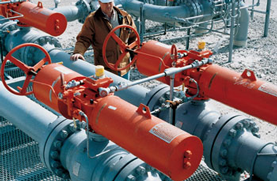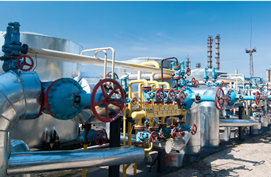
Floating ball valves are widely used across most manufacturing plants in the Oil and Gas, Petrochemicals and Refining industry. They are cheaper in cost and offer a high quality sealing between the ball and seating surface. Based on the process medium, temperature, pressure of the application the seat rings could be of metal or PTFE construction.The floating ball valves work on the principle of self sealing mechanism wherein the higher the medium pressure the higher the sealing between the ball and seat ring on the downstream side of the valve.
However there are a few disadvantages if the valve is being cycled frequently. The friction between the sealing surfaces can be quite large resulting in frequent scratches and deep scoring on the surface of the ball. This often calls for frequent maintenance and repairs which are expensive. The other challenge being high operating torque which can be a disadvantage for frequent quick shut off applications. Mounting a gear box operator manual/motorised can be rather expensive in place of the lever handle operator whose dimensions are limited by ISO14313 and API6D standards.
Some of the challenges with regards to high operating torque can be addressed by reducing the co-efficient of friction between the sealing surfaces. Using PTFE as a material of construction (MOC) for seat rings instead of metal seat rings can reduce the friction between the ball and the seat ring, however it may not be enough to reduce the operating torque significantly. Further compromising on the design of trim parts to reduce operating torque viz; increasing the stem diameter may lead to alteration of dimensions of other valve parts resulting in an overall increase in cost of the valve. Also using PTFE seat rings may not always be ideal for the chosen process medium, temperature and pressure of the process application. This could have a bearing on the life time value of the valve as a whole.
Many valve design engineers have tried to work on the design of the floating ball valve to overcome the above challenge. As the seats are fixed and the ball is floating, there is a larger movement of the floating ball along with the flow medium pressure. The higher the flow pressure the higher the tilt of the floating ball and higher the sealing against the downstream seat of the valve. As a result of this tilting action the flow pressure is applied on the whole circular area of the ball minus the area of the ball covered by the downstream seat. The higher closing torque or Force required to operate this valve is largely a result of (F = p X A) (Force = pressure X Area)
The Trunion mounted ball valve was thus designed to overcome the above challenges. It has a robust design wherein the ball is mounted on bearings and its motion is restricted to rotary motion only along its axis. The seats are designed to move a litlle bit in the flow direction thus sealing the upstream seat against the surface of the ball offering a tight shut off. In the Trunion mounted ball valve the force required to operate the valve is much lesser than the floating ball valve as the medium pressure is applied over a smaller area of the ball covered by the upstream seat. Some of the key advantages of the Trunion mounted ball valve over the floating ball valve design are lower operating torque required, reduced wear and tear of the sealing surfaces. However some of the disadvantages include higher cost of the valve due to its robust design.

 Hot new
Hot new Hot new
Hot new